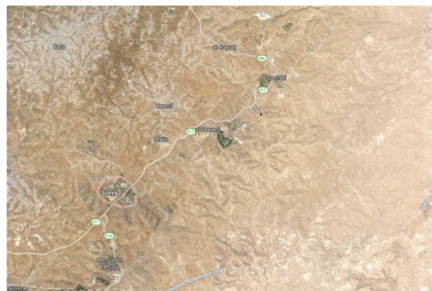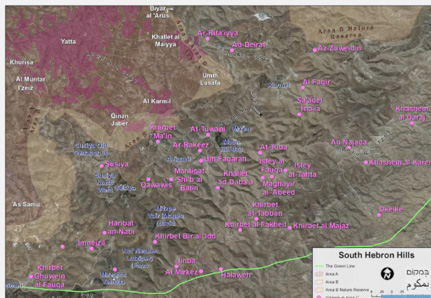Did you know that Truthout is a nonprofit and independently funded by readers like you? If you value what we do, please support our work with a donation.
With President-elect Donald Trump’s announcement that he is nominating David Friedman to fill the post of US ambassador to Israel — a person who has declared a two-state solution to be a “suicidal peace” with “radical Islamists” and who has accused American Jews who support such a measure of being no better than Nazis — concern that further demolitions will follow under the Trump regime has added more urgency to ongoing efforts to save Palestinian villages from being demolished.
The current struggle to demand that the Israeli government, Google and Apple Maps acknowledge and mark the existence of Palestinian villages, such as Susya, is a rare instance in which US politicians have stood up to Israel in a meaningful way.
For many years, Israel has been intent on demolishing the Palestinian village of Susya and displacing its 300 some residents. This act of dispossession has attracted some unlikely opponents.
Through a series of letters, since 2015, California Sen. Dianne Feinstein, well known for her ardent support of Israel, has opposed the demolitions in a debate with Israeli Prime Minister Benjamin Netanyahu.
Rep. Anna Eshoo (D-California) also recently drew attention to this issue. She wrote to Secretary of State John Kerry, urging him “to take immediate action to prevent the demolition of the Palestinian village of Susiya,” and — according to Rabbi Arik Ascherman, co-founder of the Israeli interfaith human rights NGO Haqel (The Field) — also conveyed GPS data files to Google so that it could place hundreds of missing Palestinian villages on its maps. Similarly, Rep. Mike Honda (D-California) asked Apple to make those villages visible on its maps.
Why are these mainstream liberal politicians suddenly so interested in this tiny village, and why do they see these hi-tech maps as so crucial?
As Feinstein notes in her July 28, 2015, letter to Netanyahu:
The village has existed in the South Hebron Hills at least since the 1830s … the residents have made good-faith efforts to inhabit their homes legally. For instance, in October 2013, the ICA [Israeli Civil Administration] rejected a proposed master plan drafted with the support of an Israeli NGO, Rabbis for Human Rights, which would have allowed [Susya’s] residents to build homes legally and connect to the available water and power grids…. Demolishing civilian structures and displacing innocent families … undermines Israel’s security and isolates it from the community of nations.
However, this argument does not seem to bear much force in relation to the decision-making of Israeli politicians.
It’s clear that so long as Israel denies these permits, making the structures permanently illegal, it can claim to “lawfully” demolish these villages and in many cases continue its expansion of Jewish settlements. The US State Department — and indeed, the world community — recognizes these settlements as illegal and as an obstacle to peace. Israel’s recent response has been to unilaterally declare them “legal.” We can see this battle, then, as part of a diplomatic war over what is actually legal and what is deemed to be so by one of the protagonists for their self-interest alone.
One of the linchpins in Israel’s argument is that the land in question was never really inhabited by Palestinians, and here is where maps play a critical role. In his August 11, 2015, letter to Feinstein, Netanyahu claims, “Contrary to Palestinian claims that the area has been inhabited for decades, only a handful of structures continued to expand their illegal construction by exploiting a cease and desist order that temporarily prohibited Israel from demolishing these structures.” In contrast to this claim, Mitchell Plitnick, vice president of the Foundation for Middle East Peacenotes,
According to the Israeli human rights group, B’Tselem, “The Palestinian village of Khirbet Susiya has existed for at least a century. It appears on maps as far back as 1917 — decades before Israel began occupying the West Bank. Aerial photographs from 1980 show cultivated farmland and livestock pens, indicating the presence of an active community there.”
So who is right, and what evidence is there to support either claim?
Maps can be essential testaments to human presence, history and culture. They are also highly politicized — shaped by the mapmaker’s own political vision, which informs the contours, dimensions, spaces and status of any item, or even its existence. In our hi-tech world, where we are so reliant on digital media to locate ourselves in our surroundings, images appear and disappear with a keystroke. And this is dangerous. Only recently the West Bank and Gaza suddenly “disappeared” from Google maps. Google insisted this was simply the result of a “bug.”
But what is going on in the case of the destruction of these villages is quite different, because it is calculated.
In October 2016 a group of Palestinians working with the Rebuilding Alliance of Burlingame, California, delivered letters to the Silicon Valley headquarters of Google and Apple, requesting that they both update their maps with data that had been missing. Donna Baranski-Walker, founder and executive director of the Alliance explained to Truthout that “on Apple Maps, at least 550 villages were invisible to the world. Google Maps miss about 220 villages (the ones in Area C).” Currently, Google Maps and Apple Maps show Israeli settlements and outposts, which are illegal under international law and violate official US policy, while erroneously depicting an empty countryside that in reality contains hundreds of Palestinian villages.

 The top map featured here is the current Google map of South Hebron Hills near the Israeli Settlement of Susiya. The map below it shows what the area actually looks like, including the Palestinian village of Susiya and the neighboring villages. (Images: Bimkom: Planners for Planning Rights)
The top map featured here is the current Google map of South Hebron Hills near the Israeli Settlement of Susiya. The map below it shows what the area actually looks like, including the Palestinian village of Susiya and the neighboring villages. (Images: Bimkom: Planners for Planning Rights)
A November press release from Rebuilding Alliance quotes Nava Sheer, a GIS mapping expert at Bimkom: Planners for Planning Rights. According to Sheer:
Thousands of children and families in Area C of the West Bank can’t locate their homes on Apple or Google maps, or on Waze (Google’s subsidiary) … They are real locations — however, in the virtual mapped world of the Web, they simply can’t be found. In today’s online society, that’s as good as saying you don’t exist.
Rabbi Ascherman insists that this is a human rights issue, not an issue of Israel’s security. He told Truthout, “This is a human rights issue because the entire might of Israel is focused on removing Susya from the face of the Earth.” And Susya is just one of hundreds of such villages. According to Ascherman, this situation is a longstanding one, with some villages being destroyed again and again, and this is part of a larger political project that has been going on for years, with terrible effects. Ascherman says:
These people have been moved and displaced time after time after time. The psychological toll on people is devastating. People end up in therapy and children … are traumatized for life. People need to understand that a) it is not a benign or neutral process. It’s a very intensively political process and b) that it’s not about security…. This is part of an intentional, political effort to displace Palestinians to allow for the expansion of settlements.
In a recent op-ed, Rabbi Ascherman stressed that grassroots efforts are a key element in the struggle to make the human face of the Palestinians visible:
This is where average citizens come in. The great interest shown by the U.S. and other governments is a direct result of constituents pressing their representatives to express concern on their behalf. This is our best hope to maintain U.S. engagement in keeping Palestinian villages standing. Citizens are also working to make these villages visible and give them back their identity.
The question of whether or not Democrats will stand up to fight the most egregious acts of violence is an open one, but the main point is this: Politicians rarely do anything that might endanger their re-election unless they are pushed by grassroots efforts, persistently and vociferously.
What we are talking about in this specific case is the erasure of a people and a culture, all premised on the assertion that they simply do not exist anyway. This is being done to install in their place illegal settlements, and to populate the land as part of a longstanding settler colonial project. In a “post-truth” world, where facts and reality itself are too often simply the products of the powerful who want even more of the world under their control, these actions undertaken by the Rebuilding Alliance and Haqel are strong examples of how people can fight back and resist falsification and erasure, both on maps and in the world itself.
Media that fights fascism
Truthout is funded almost entirely by readers — that’s why we can speak truth to power and cut against the mainstream narrative. But independent journalists at Truthout face mounting political repression under Trump.
We rely on your support to survive McCarthyist censorship. Please make a tax-deductible one-time or monthly donation.